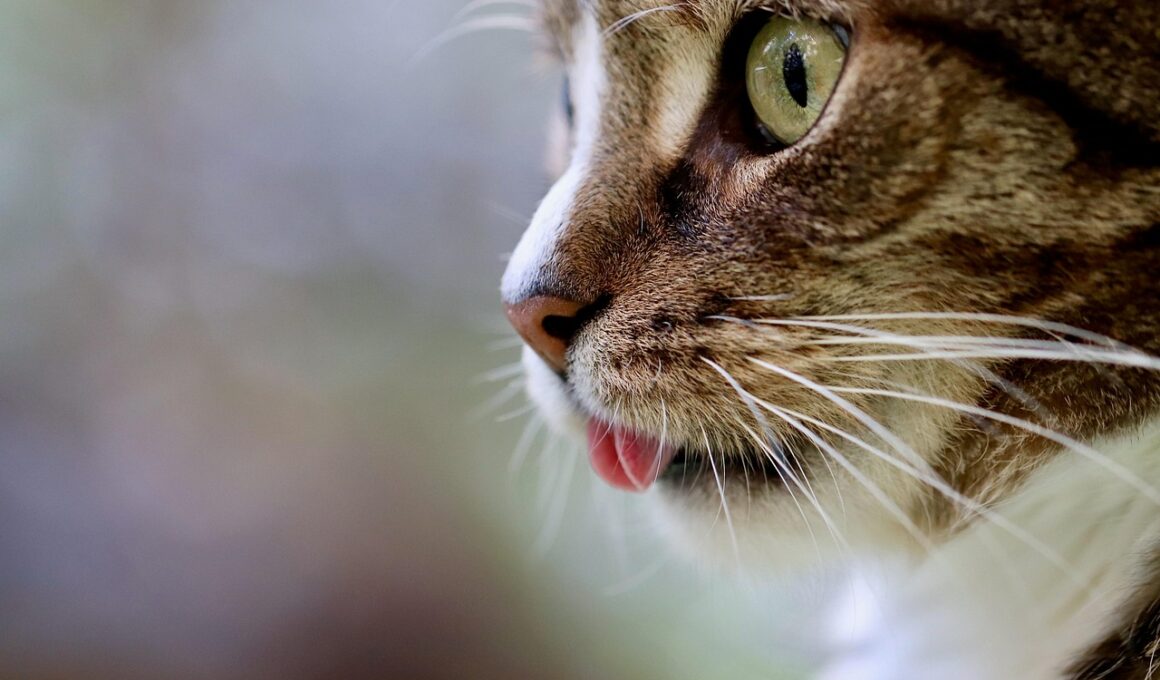Monitoring Progress in Your Cat’s Show Training Program
Training your cat for shows is an extensive process that requires patience and dedication. Regular progress monitoring is crucial to ensure your cat develops the necessary skills and confidence. Start by setting specific training goals each week. These goals should be achievable and allow for progress assessment. Use a training journal to document your cat’s progress, including any challenges faced. This can provide a comprehensive overview of how your cat is developing. A consistent approach will help your cat recognize routines while remaining engaged. Every training session should be productive and engaging for your feline friend. Include interactive elements like toys or treats to maintain their focus. Regular evaluations can include assessing behavior, presentation skills, and overall confidence levels. You might also consult with professional trainers or experienced show participants for specific guidance. Discussing areas for improvement can provide new insights for your training regimen. Take videos during practice sessions to visualize your cat’s progress over time. Identify strengths and weaknesses, thus developing a strategy for further training. Utilization of a structured approach often yields the best results without overwhelming your cat.
Incorporating Regular Assessments into Your Training Routine
Consistency is essential when training your cat for shows. Embed regular assessments into your training routine to gauge your cat’s performance effectively. Aim to have assessments after every five sessions, focusing on specific areas you’ve been working on. Document your observations regarding behavior, movement, and response during these assessments. This helps track progress and allows you to adjust training techniques if needed. For instance, if your cat consistently struggles with a particular command, consider revisiting that section of training. Incorporating various environments into your assessments may also be helpful. Practice in the home setting, as well as outside, or even at a friend’s place. This exposes your cat to different distractions and situations, similar to what they might encounter at a show. Use treats as rewards to reinforce good behavior and responses during assessments. Involve family members or friends to help simulate a show environment. This can help alleviate any stress your cat may have when exposed to larger audiences. Regular assessments not only build skills but also enhance your bond with your cat as you share these experiences together.
Setting Achievable Goals
Defining measurable, realistic, and achievable goals guarantees a focus during training. Each goal should be clear and achievable within a specified timeframe. For example, a goal could be as simple as improving your cat’s ability to walk on a leash or respond to a specific cue. Break complex tasks into smaller, achievable objectives, thus allowing for gradual progress. Celebrate milestones, however small, as they can boost you and your cat’s confidence significantly. This increases motivation for both of you, turning training into a positive experience. Use a calendar or a dedicated app to track goals and accomplishments. Visual indicators of your cat’s progress can motivate both of you. Creating a checklist can also help in ensuring that you don’t miss any crucial aspects of training. Also, involve your cat’s needs and personality when setting goals. For instance, if your cat is anxious, initial goals may focus on building confidence rather than perfection in performance. This approach lays a solid foundation and fosters trust in you as their trainer while making progress seem attainable and encouraging throughout the journey.
Utilizing Technology for Training Progress
Modern technology provides numerous tools to assist in monitoring your cat’s training progress. One popular way is to use mobile applications designed for pet training. These apps often come with instructional videos, tracking features, and reminders for training sessions. Additionally, many offer ways to document your cat’s behavior and performance, making progress tracking easier. Another benefit of technology is the ability to capture training sessions on video. Recording your cat during practice allows you to see improvements over time and correct issues in real-time. You can share these recordings with trainers or fellow enthusiasts for feedback. Social media also offers communities that focus specifically on cat shows. Engaging in online forums and groups can provide you with tips and encouragement from like-minded individuals. Use platforms like Instagram to post your cat’s achievements, showcasing their progress. This can foster a supportive network that celebrates successes and provides constructive advice. Monitoring apps can also send notifications for regular assessments, helping to keep your training program on track and organized. In conclusion, leveraging technology augmentations can facilitate a streamlined approach to your cat training.
Engaging with a Community
Connecting with fellow cat owners and trainers can significantly benefit your cat’s training program. Participating in local cat shows can provide firsthand experience while allowing you to interact with others having similar interests. These gatherings often showcase various breeds, allowing you to observe how others train their cats. Engaging in discussions during these events can yield valuable insights, tips, and strategies that enhance your own training regimen. Furthermore, online platforms and forums can provide wider access to global communities focused on cat shows. These platforms allow you to share challenges and successes, seeking advice or simply offering support to others. Many of these communities host workshops or online training segments, valuable resources for trainers of all skill levels. Networking effectively within these circles can lead to learning about competitions and new training techniques. Seek out mentors who can provide guidance and facilitate your learning process. They may share valuable anecdotes and experiences that could positively influence your cat’s show training. Ultimately, building a support network fosters an enriching training environment both for you and your feline friend.
Adapting Your Training Approach
While consistency is vital, adaptability is equally important in your cat shows training program. Every cat has a unique personality and learning style, which may require different training techniques. Take note of your cat’s reactions to various methods and be prepared to adjust your approach as necessary. If you notice that a certain technique causes stress or discomfort, it may be beneficial to try different methods or activities. Implement techniques that create a positive learning environment, such as play-based training. This allows cats to remain excited and engaged during sessions. Additionally, consider their energy levels during training sessions. Some cats perform best in the morning, while others might shine later in the day. Experiment with different times to find the sweet spot for both of you. Always keep your training sessions short yet effective to maintain your cat’s enthusiasm. Utilize early successes as building blocks for more complex tasks. Recognize that training your cat for shows is a journey that requires commitment and a flexible mindset. Patience and understanding often lead to remarkable transformations in their behavior and overall performance.
Reflecting on Progress and Next Steps
After several weeks of consistent training and monitoring, take time to reflect on the progress you’ve made. Sit down and look back through your training journal. Assess successful areas and identify aspects needing further improvement or focus. Reviewing videos can also provide insight into changes in your cat’s movement and confidence levels. Engage friends or fellow trainers for feedback, as outside perspectives may highlight points you might have missed. Set aside time to plan the next phase of training based on your reflections. This can include introducing new commands, environments, or distractions, keeping your cat engaged and challenged. Consolidating your progress may also require celebrating your own achievements and those of your cat. Do not underestimate the positive reinforcement of celebrating milestones together, as this strengthens your bond. In summary, reflecting on your training journey is as essential as the training itself. Create action steps for the next stages and continually adapt as your training progresses and your cat develops. Keep adapting and striving for excellence as a dedicated trainer.
Final Thoughts on Cat Show Training
Ending on a positive note about your training journey can offer valuable motivation to keep pushing forward. Every step taken is a part of the broader experience of raising a confident, well-trained show cat. Remember that patience and consistent effort play significant roles in success. It’s critical to celebrate every win, no matter how small, and recognize the love that bonds you and your cat throughout this experience. Each training session forms a stepping stone towards achieving your ultimate show goals. Keep in mind that success in cat shows isn’t solely measured by awards but by the relationship developed with your cat. Strive to foster a healthy balance between training and bonding time; let your sessions be enjoyable rather than merely focused on outcomes. Participate in community activities, share experiences, and learn from each other. The growth you witness in your cat will reflect your dedication and care. Ultimately, this journey enhances the understanding you share, creating memories and skills that last a lifetime. Continue with optimism; carry forward the lessons learned, always looking for new ways to enrich your training and bonds.


